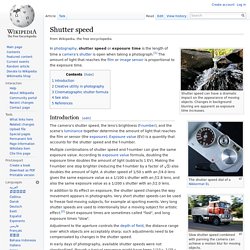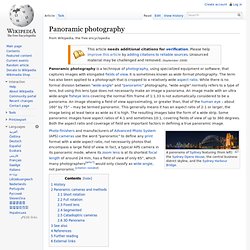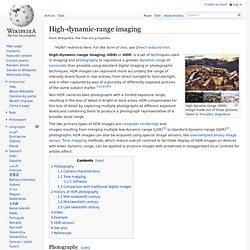

Aperture. A large (1) and a small (2) aperture Aperture mechanism of Canon 50mm f/1.8 II lens, with 5 blades Definitions of Aperture in the 1707 Glossographia Anglicana Nova[1] In some contexts, especially in photography and astronomy, aperture refers to the diameter of the aperture stop rather than the physical stop or the opening itself.

For example, in a telescope the aperture stop is typically the edges of the objective lens or mirror (or of the mount that holds it). One then speaks of a telescope as having, for example, a 100 centimeter aperture. Sometimes stops and diaphragms are called apertures, even when they are not the aperture stop of the system. Application[edit] The aperture stop is an important element in most optical designs. The size of the stop is one factor that affects depth of field. In addition to an aperture stop, a photographic lens may have one or more field stops, which limit the system's field of view. Shutter speed. Shutter speed can have a dramatic impact on the appearance of moving objects.

Changes in background blurring are apparent as exposure time increases. Slow shutter speed combined with panning the camera can achieve a motion blur for moving objects. Introduction[edit] Multiple combinations of shutter speed and f-number can give the same exposure value. According to exposure value formula, doubling the exposure time doubles the amount of light (subtracts 1 EV). ) also doubles the amount of light. In addition to its effect on exposure, the shutter speed changes the way movement appears in photographs. Adjustment to the aperture controls the depth of field, the distance range over which objects are acceptably sharp; such adjustments need to be compensated by changes in the shutter speed. In early days of photography, available shutter speeds were not standardized, though a typical sequence might have been 1/10 s, 1/25 s, 1/50 s, 1/100 s, 1/200 s and 1/500 s. Main article: Motion blur. Panoramic photography. Photo-finishers and manufacturers of Advanced Photo System (APS) cameras use the word "panoramic" to define any print format with a wide aspect ratio, not necessarily photos that encompass a large field of view.

In fact, a typical APS camera in its panoramic mode, where its zoom lens is at its shortest focal length of around 24 mm, has a field of view of only 65°, which many photographers[who?] Would only classify as wide-angle, not panoramic. [citation needed] History[edit] One of the first recorded patents for a panoramic camera was submitted by Joseph Puchberger in Austria in 1843 for a hand-cranked, 150° field of view, 8-inch focal length camera that exposed a relatively large Daguerreotype, up to 24 inches (610 mm) long. An 1851 panoramic showing San Francisco from Rincon Hill by photographer Martin Behrmanx. Following the invention of flexible film in 1888, panoramic photography was revolutionised. Panoramic cameras and methods[edit] Digital video. Digital video is a type of digital recording system that works by using a digital rather than an analog video signal.

The terms camera, video camera, and camcorder are used interchangeably in this article. History[edit] Starting in the late 1970s to the early 1980s, several types of video production equipment that were digital in their internal workings were introduced, such as time base correctors (TBC) and digital video effects (DVE) units (one of the former being the Thomson-CSF 9100 Digital Video Processor, an internally all-digital full-frame TBC introduced in 1980, and two of the latter being the Ampex ADO, and the Nippon Electric Corporation (NEC) DVE). They operated by taking a standard analog composite video input and digitizing it internally. Largest photographs in the world. Most of the photographs that are claimed to be the largest are stitched from smaller images.

The Legacy Project photograph made in Irvine, California, is an exception to this in that it was made as a single exposure on a seamless piece of sensitized fabric using a building as a huge camera. Print[edit] The largest seamless photograph made in a single exposure was made using a Southern California jet hangar transformed into a giant camera. The most recent claim to the largest image stitched together was by the Canadian Museum of Civilization. Negative[edit] The longest photographic negative measures 39.54m (129 ft 8.69 in) in length and was created by Esteban Pastorino Díaz (Spain) using a custom-built panoramic slit camera on June 13, 2010. Largest seamless example[edit] Orthorectified negative (top) and positive (bottom) representations of The Great Picture, partially obscured by two people. Largest example assembled from multiple pieces[edit]
High dynamic range imaging. High-dynamic-range (HDR) image made out of three pictures.

Taken in Tronador, Argentina. High-dynamic-range imaging (HDRI or HDR) is a set of techniques used in imaging and photography to reproduce a greater dynamic range of luminosity than possible using standard digital imaging or photographic techniques. HDR images can represent more accurately the range of intensity levels found in real scenes, from direct sunlight to faint starlight, and is often captured by way of a plurality of differently exposed pictures of the same subject matter.[1][2][3][4] Non-HDR cameras take photographs with a limited exposure range, resulting in the loss of detail in bright or dark areas. HDR compensates for this loss of detail by capturing multiple photographs at different exposure levels and combining them to produce a photograph representative of a broader tonal range.